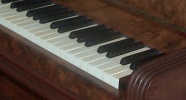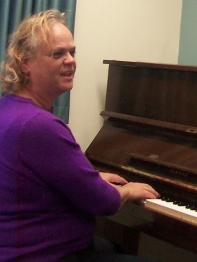
Tuition & coaching in voice (singing & speech), vocal health
piano, music theory, keyboard harmony
piano solo, piano accompaniment. Perth, Western Australia
www.piano.mixmargaret.com


How to tune,
repair etc
your old piano
eBooks &
Free Reports
Find your piano's
Age & Value
The Singing Zone
Per Bristow's
home study
voice method
| Mix Margaret Dylan Jones |
|
Piano Repair & Tuning:
What To Look For
in a Secondhand Piano (Tuning Pins, Cracked Wrest Planks) Article by Margaret Dylan Jones
You can pick up an old antique piano for $400. I know, because I just sold one. But how do you know if it's worth buying at all? Will it be repairable and will it be OK for your child to learn on? You need to know what to look for. The wrest plank and tuning pins of my Moore & Moore upright piano all looked excellent. It was one of the best I'd ever seen in that respect--there was no evidence of damaged or abused pins, they all looked original, none had been hammered in, none had marks on them, they were not bent and there were no signs of cracks or other damage to the wrest plank. The sound board (the largest piece of wood, behind the strings in the centre of the instrument) had no cracks either, and the strings all looked fine. The action (the moving parts) worked well on all the notes, and the dampers stopped the sound of each note when you lifted the key or raised the damper pedal. There was one missing plastic key, but that would be easy to replace. Most old pianos would not look so good on the inside. Then, a couple of weeks later I got a complaint from the very disappointed buyer: "Hi Margaret. After we had the piano delivered we got a piano tuner out and were really disappointed...it was unable to be tuned...when the tuner tried to tighten the pins they would unwind straight away and she said it was no good at all...so we have hired a piano. When the guys came out to deliver the [new] piano they also said "No, that's cactus..." But the piano was actually quite tunable, and the inside workings were in very good condition. Eventually, after more advice from me, the buyer realised he'd found a very useable instrument. The skill of the tuner is paramount to keeping the strings and tuning pins 'on pitch.' When living in the remote town of Karratha, I taught myself to tune a very old piano in much worse condition than this. I also did some tunings on a couple of my students' old pianos. In all cases it was very difficult to keep them in tune for more than a few minutes, partly due to my poor technique with the tuning hammer (lever). However, when a professional tuner came to town he did a marvellous job and the three rickety old pianos stayed well in tune for many months. When a piano has not been tuned for some years it may require more than one tuning to 'come up to pitch.' It's impossible to know how well this is going to pan out, you can only try it and see how many tunings it needs. The strings have tonnes of tension and you have to wait for the tension to even out before doing another tuning. It can take months before the tuning settles. When he bought my Moore & Moore piano I told him it needed re-hydrating (it needed more water or moisture in the wood). If the wrest plank had dried out the pins would certainly be loose. In Karratha we re-hydrated all three old pianos and it made a BIG difference. The simple cure is to place a beaker of water inside the piano at the bottom. The bigger, the better, because people tend to forget about them and they eventually run out of water. It takes weeks to have an effect. This re-hydrating also seemed to fix an action problem that two of our pianos had. Some tuners don't like water beakers, they reckon they will cause problems with the action or rust the strings so expert advice should be sought from a professional technician, but it worked well for us. There are commercially-available humidifiers/de-humidifiers specially made for pianos. Another cheap technique to help with the tuning is to hammer the pins into the wrest plank. It's a standard remedy but there's a limit to how much and how often the pins can be hammered in. The pins on this old piano looked like they'd never been hammered at all, so that was still a viable option. It's definitely a job for a skilled piano technician, to avoid damage to the pins or wrest plank. A much more expensive technique is to replace the pins with larger pins (they come in different sizes), but it would be a big undertaking and it would be cheaper to get another piano. In the end the buyer was very happy with his piano, it turned out to be quite a good instrument. Margaret D. Jones, MusB(UWA), DipEd, LTCL, ATCL, AMusTCL, AMusA, is a composer, piano accompanist and voice teacher, whose first non-musical(?) hobby was examining old pianos at auctions with a torchlight and a tuning fork. For detailed photos of the pianos referred to, and more about old pianos, see www.Recommended-Reviewed-Music-Resources.mixmargaret.com. (C) 2010 Mix M D Jones. http://EzineArticles.com/?expert=Margaret_Dylan_Jones. Note to webmasters: you're welcome to copy this article to your site, royalty-free, providing you keep the whole document intact including the resource box and this note. |